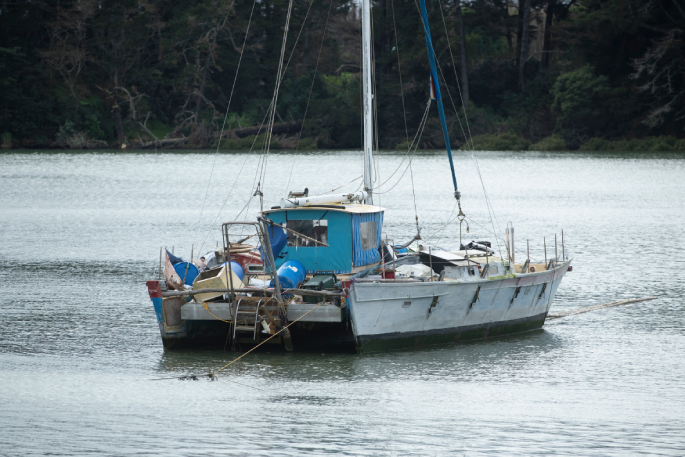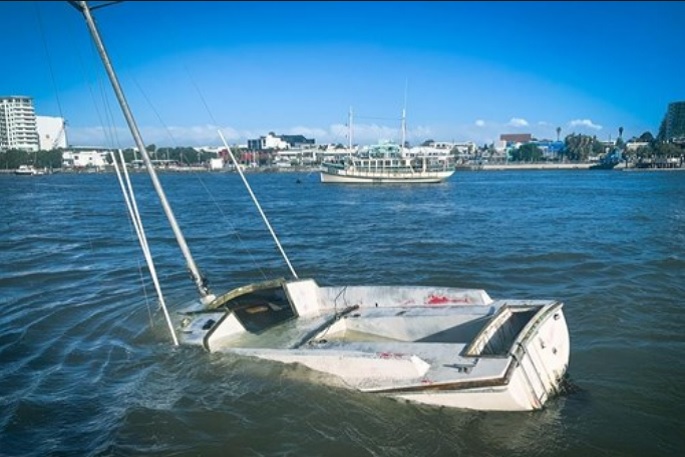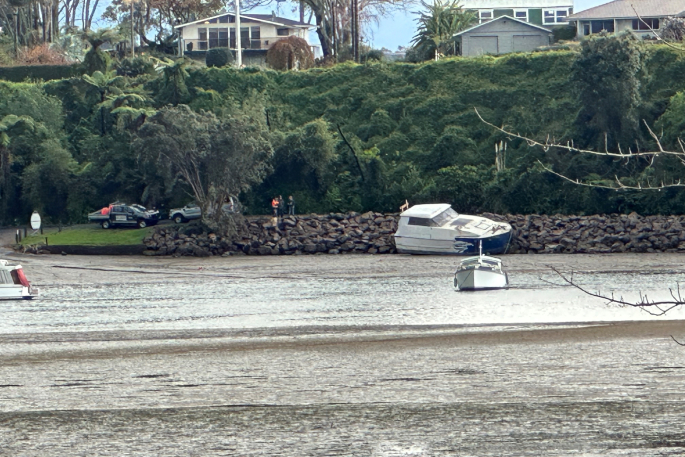The grounding of a boat in the Te Puna Estuary has raised questions from local boaties about the condition and mooring of some of the more derelict vessels in the area.
The Eagle Hawk grounded at Plummers Point on the weekend but was successfully re-floated on Tuesday morning.
'This was intentionally beached by the boat owner prior to the weekend,” says Tauranga Harbourmaster Jon Jon Peters.
'The owner was told on Friday that we were concerned with its location and that it needed to be checked immediately as it was not adequately anchored.
'Due to the bad weather on Sunday night, one of our staff checked on Eagle yesterday [Monday] and found it had dragged up to the rock embankment near the Plummers Pt boat ramp.
'The vessel was checked for damage, and the owner was called to attend and [it was] successfully re-floated this morning by the boat owner.”
A Te Puna resident says there are other vessels in the estuary that are causing some concern for locals, due to ropes tied to them that may be a risk to other boats.
'There are two derelict boats up near the railway bridge that goes to Newman Road at Plummers Point. A catamaran and another boat. They've been anchored up there for a few months, since before Christmas,” says a Te Puna resident.
'I kayaked up there the other day at low tide and he has each side of the bow tied to stakes that he's put in. If you were scooting up there in a dingy you would hit it.
'The other boat has a long rope tying it to the shore on both sides.”
 A catamaran anchored in the Te Puna estuary with ropes tied out from its bow and stern. Photo: John Borren.
A catamaran anchored in the Te Puna estuary with ropes tied out from its bow and stern. Photo: John Borren.
Jon Jon says there are no designated prohibited anchorage or restricted anchorage areas in the Te Puna area, so a boat owner can anchor in these general locations.
'Under the Bay of Plenty Navigation Safety Bylaw 2017, there is a rule that a vessel may not be anchored within the same or proximate location within the Tauranga Harbour for a period longer than 14 consecutive days annually without prior approval of the Harbourmaster.”
Mooring maps for Omokoroa and Te Puna/Plummers Point are available on the Bay of Plenty Regional Council website.
The two boats near the railway bridge appear to be located outside of these mooring areas, however the harbourmaster says they are not installed moorings but the boats are anchored.
'Our staff do regular checks for illegally moored boats. We are currently speaking with the individual boat owners to resolve the issues.”
 A boat anchored in the Te Puna estuary with a rope tied to it from shore. Photo: John Borren.
A boat anchored in the Te Puna estuary with a rope tied to it from shore. Photo: John Borren.
Residential moorings are also possible.
'People can live aboard their vessels, however the discharge of untreated sewage is prohibited anywhere in Tauranga Harbour.
'If living aboard or staying overnight on your boat - it must be equipped with a sewage treatment system or holding tank, or have a portable toilet on board.”
When a boat is seen to be sinking, grounding, or is in difficulty, the Harbour Master's first action is to notify the boat owner to let them know there is an issue with their boat.
'If there is no response or immediate action is required, our team will attend.”
 A boat sank at its mooring in May in Tauranga harbour. Photo: Bay of Plenty Regional Council.
A boat sank at its mooring in May in Tauranga harbour. Photo: Bay of Plenty Regional Council.
Last month the discovery of a sunken launch at its mooring in Tauranga harbour prompted Bay of Plenty Regional Council to remind boat owners to check their moorings.
"With the current bad weather it's important for you to check on your boats and their bilge pumps," says a council spokesperson.
"Unfortunately this launch sank quite quickly in Tauranga harbour.
"We're investigating the cause and working to recover the vessel but the current weather is making this challenging. Stay safe out there!"
In 2022, Bay of Plenty Regional Council's Harbourmaster team said it had had its busiest winter in recent memory assisting with the salvage of a number of boats in Tauranga Harbour.
The last week in July 2022 alone saw four vessels needing assistance from the Harbourmaster team after heavy rain and strong winds.
 A boat that sank in July 2022 in Tauranga harbour. Photo: BOP Regional Council.
A boat that sank in July 2022 in Tauranga harbour. Photo: BOP Regional Council.
One vessel was partly submerged needing water to be pumped out and the boat removed from the Harbour, while another sunk to the seafloor. Two other vessels broke free from their mooring and anchor.
The salvage operations that follow these are a stark reminder for boat owners to check their vessels on moorings.
With cloudy days, owners of vessels relying on solar should also be checking battery levels to ensure automatic bilge pumps are operating.
It is essential that boat owners check on their vessels regularly to catch any issues early.
The July 2022 incidents were caused by a mooring line chafing/wearing on a sharp edge, and boats slowly taking on rainwater and the bilge pump failing. These could have been easily prevented with some regular maintenance checks.
Salvaging a boat that has sunk on its mooring can be a costly exercise for the owner with the bill coming in between $10-$15,000 per day for a commercial dive team and suitable barge.
The boat owner is liable for these costs and dependent on the size of the boat and how long it takes to get it out of the water it can cost much more.
In some cases the boat may be disposed of and destroyed by the Regional Council under the authority of the Maritime Transport Act 1994 with the boat owner liable for all costs incurred.
A mooring refers to an approved structure to which a vessel may be secured. In the Bay of Plenty there are more than 490 designated swing moorings spread across Tauranga, Whakatāne and Ōhiwa harbours.
These areas are identified in the Navigation Safety Bylaw.
To read more about Bay of Plenty moorings and boating in the bay, click here www.boprc.govt.nz/living-in-the-bay/boating-in-the-bay/moorings



1 comment
Time to get tough
Posted on 08-06-2023 08:34 | By Lucky_Luke
The misuse of moorings, particularly with derelict vessels, is a significant issue in the Bay of Plenty1. These boats not only pose a risk, but the practice of banking and selling moorings for a profit exacerbates the problem. Our current bylaws, including the 14-day anchoring rule, are insufficient1. We need a comprehensive overhaul that requires mandatory insurance, enforced usage, and regular seaworthiness inspections. Boats that fail these criteria should be ordered to be removed or destroyed, at the owner's expense. The practice of profiting from moorings needs strict regulation. Our harbourmaster team shouldn't be overburdened with salvaging neglected boats1. It's time to clean up our waters, ensure safety, and prevent the misuse of our precious moorings in the Bay of Plenty.
Leave a Comment
You must be logged in to make a comment.